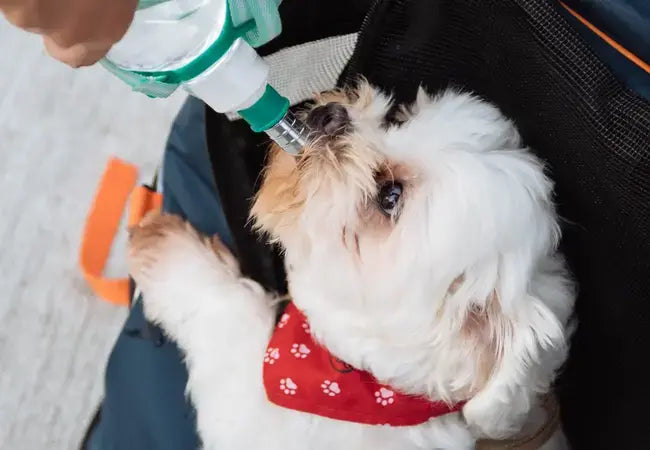2025 Vet Guide: Is Pedialyte Safe for Dogs? Expert Vet Insight 🩺🐾

In this article
2025 Vet Guide: Is Pedialyte Safe for Dogs? Expert Vet Insight 🩺🐾
By Dr. Duncan Houston BVSc
Hello! I’m Dr Duncan Houston BVSc, veterinarian and founder of Ask A Vet. In 2025, many pet owners ask whether human electrolyte drinks like Pedialyte can help a dehydrated dog. This article explores the science behind Pedialyte, its uses and dangers, when it's appropriate, and safer alternatives—all to help you support your pup wisely. 😊
1. What Is Pedialyte & Why It’s Popular 💧
Pedialyte is an oral electrolyte solution designed for dehydrated humans—infants, children or adults—replenishing sodium, potassium, chloride, and sugars lost through vomiting, diarrhea, or heavy exercise.
- Human-designed formula: Concentrations tailored for human physiology, not canine needs.
- Accessible & convenient: Over-the-counter, pre-mixed so you can offer it immediately.
2. Is Pedialyte Safe for Dogs?
✅ When It Might Be Safe
In small quantities, **unflavored** Pedialyte can be safe for dogs under veterinary guidance, particularly when:
- Mixed 1:1 with water to reduce sodium and sugar levels.
- Given briefly after mild vomiting or diarrhea, when vet care has already sought.
- Used as part of a shelter or parvovirus protocol in stable puppies, with professional oversight.
❌ Risks and Warnings
- High sodium/electrolyte load unsuitable for dogs, especially with health conditions.
- Contains sugar (and sometimes artificial sweeteners like sucralose or xylitol) dangerous for diabetic or sensitive dogs.
- May exacerbate vomiting or diarrhea in some dogs, delaying proper vet care.
- Dilution with water is crucial—undiluted formula poses more risk.
3. Consult a Vet First 🩺
Vet input is essential because dehydration is often a symptom, not a disease itself. Vets may advise:
- IV fluids or subcutaneous fluids—standard treatment for moderate to severe dehydration.
- Plain water, electrolytes, and dietary modifications at home for mild illness.
- Use of diluted Pedialyte selectively and temporarily for stable dogs, or if pups aren't drinking water.
- Importance of diagnosing underlying causes (parvo, kidney disease, heat, pancreatitis, etc.).
4. Dosing Guidelines (Vet Approved)
There’s no universal dosage—consult your vet. One recommendation is:
- 2–4 mL Pedialyte per pound of body weight diluted 50/50 with water, given hourly or every 1–2 hours.
- Puppies: use unflavored product; flavored types often appeal more.
Caution: offer in small sips to prevent vomiting relapse.
5. Alternatives to Pedialyte
- Plain, fresh water: Usually enough for mild dehydration.
- Vet-formulated canine electrolyte solutions: Specifically designed for dog physiology.
- DIY home electrolyte mix: Water + ½ tsp salt + ½ tsp baking soda + 4 T sugar or honey—cooled and given in small amounts.
- Subcutaneous fluids: Administered at home or in vet clinic for moderate cases.
- Bland diet: Cooked rice and chicken or prescription gut diet post-12-hour fast reduces GI upset.
6. When to Call the Vet Immediately
Don’t delay vet care if your dog shows:
- Persistent vomiting or diarrhea
- Lethargy, collapse, inability to drink
- Signs of dehydration: sunken eyes, tacky gums, delayed skin tent test.
- Blood in vomit or stool
- Heatstroke or toxin exposure
In moderate to severe cases, your vet may initiate hospitalization, IV fluids, diagnostics, and medications to treat the root cause.
7. Step-By-Step Home Balance Plan
- Assess signs—mild vs moderate/severe dehydration.
- Call vet; follow guidance on fluid options.
- Prepare diluted Pedialyte only with vet OK, or homemade mix.
- Offer in small amounts every 1–2 hours, monitoring for vomiting.
- Shift to bland diet once GI quiets.
- Track hydration: skin elasticity, gum moisture, activity levels.
- Exit plan: No Pedialyte after 24 hours; revert to clean water or vet solutions.
- Vet follow-up if symptoms persist or worsen.
8. Integrating Ask A Vet Support & Products
For added assistance, the Ask A Vet app offers:
- 24/7 expert chat for pediatric and dehydration guidance
- Telehealth follow-ups for non-emergency care
- Product recommendations: canine electrolyte powders, syringe sets, soothing broth mixes from Woopf and Purrz
- Recovery trackers, medication reminders, and tailored feeding plans.
9. FAQs About Pedialyte & Dogs ❓
- Q: Is flavored Pedialyte OK?
- No—may contain artificial sweeteners or flavors harmful to dogs.
- Q: Can Pedialyte mask serious illness?
- Yes—hydration aides do not treat underlying disease; you may postpone necessary vet care.
- Q: What amount of water is proper?
- Healthy adult dogs need ~1 oz per lb daily; more with vomiting/diarrhea.
10. Final Vet Wisdom 🏁
While Pedialyte can rehydrate in a pinch, it is not a cure, and poses risks if misused. In dogs, plain water, vet-made electrolyte products, IV/subcutaneous fluids, and proper medical care are superior. Always consult a vet, especially when dehydration occurs. With expert guidance and tools like Ask A Vet, you can support your dog’s recovery safely, ensuring comfort and health. 💧🐶
Download the Ask A Vet app for 24/7 support, recovery trackers, and recommended supplies from Woopf and Purrz to keep your dog hydrated and thriving. 📱






